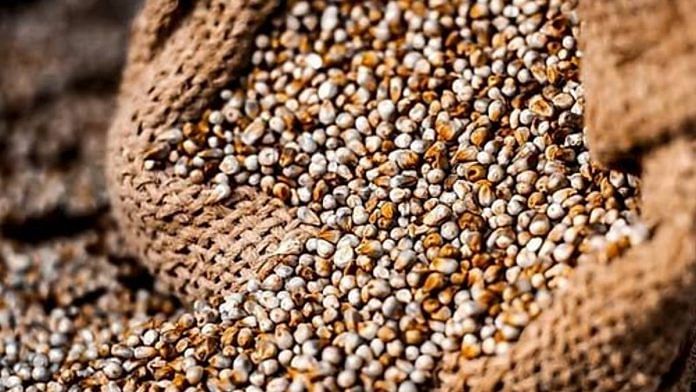New Delhi: Taller, healthier and stronger — millets can boost growth in children and adolescents by 26 to 39 per cent when they replace rice in standard meals, an India-led study has found.
The study — led by Dr S. Anitha, senior scientist, nutrition, at the International Crops Research Institute for the Semi-Arid Tropics (ICRISAT) at Patancheru, near Hyderabad — is a review and analysis of eight previously published studies, all of them conducted in India.
It was published in the journal Nutrients earlier this month.
The participants of the studies analysed included infants as well as pre-school and school-going children and adolescents. The children consumed millets — high in nutrients and protein — for a time period ranging from three months to four-and-a-half years.
Five of those studies used finger millet (ragi), one used sorghum (jowar) and two used a misxture of millets — notably finger, pearl (bajra), foxtail (kangni), little (kutki) and kodo (varagu) millets. Each of the studies had an average sample size of 65.
Among the children fed with a millet-based diet, a relative increase of 28.2 per cent in mean height and 26 per cent in weight was observed, when compared to children on regular rice-based diets, the review found. Similarly, a 39 per cent increase in the mid-upper arm circumference and 37 per cent increase in the chest circumference was also found among children with millet-based diets against the rice-based one.
Furthermore, the study found that millets-based diets help in managing type 2 diabetes, lower cholesterol levels, tackle obesity as well as anaemia.
“These results are attributable to the naturally high nutrient content of millets that exhibit high amounts of growth-promoting nutrients, especially total protein, sulphur-containing amino acids, and calcium in the case of finger millets,” Anitha told ThePrint.
“Additionally, finger millet (ragi) naturally contains high calcium levels, from which almost 23 per cent is usually retained by the body. Available evidence shows that calcium from finger millet is highly bio-available (available for absorption in the human body), and it can provide around 100 mg of bioavailable calcium per 100 grams of grain that could help overcome calcium deficiencies if consumed adequately,” added Anitha.
Also read: Read before you eat – What nutrition and ingredient labels are telling you about ‘healthy’ food
Recommending millets for various schemes
All of the studies analysed in the meta study were based on standard rice-based meals, which were then compared with millets-based ones. The researchers also studied meals enhanced with vegetables, fruits and dairy products, and came to the conclusion that they resulted in minimal additional growth if they were eaten with millets instead of rice.
According to the study, this indicates that simply replacing rice with millets — along with more diverse and nutritious foods like fruits and vegetables — can be beneficial for the growth of children.
The study also made various policy recommendations, such as developing nutrition intervention programmes to diversify staples, like giving millets in the mid-day meal scheme or the various maternal and child health programmes. Incorporating millet-based meals designed for different age groups is another recommendation.
“Implementing millet-based meals requires menus to be designed for different age groups, utilising culturally sensitive and tasty recipes. This should also be complemented with awareness and marketing campaigns to generate an understanding and interest in millets,” one of the authors of the study, Dr Hemalatha, director at India’s National Institute of Nutrition in Hyderabad, told ThePrint.
Helps in other ways too
The study also concluded that millets contain a wide range of nutrients and have been scientifically shown to contribute to serving significant health needs globally.
Not only do millets tackle child undernutrition and malnutrition, they also manage type 2 diabetes, lower total cholesterol levels, and help combat obesity and iron deficiency, which causes anaemia, the study said.
It concluded that to bring the benefits of millets to the wider society, awareness about their nutritional value is needed. Only then will demand rise, investments pour in and farm-to-fork food value chains created.
(Edited by Saikat Niyogi)
Also read: National Nutrition Month 2021: The power of a nutritious meal



